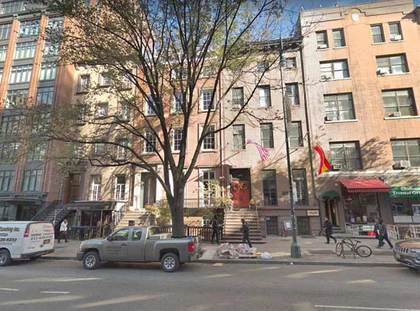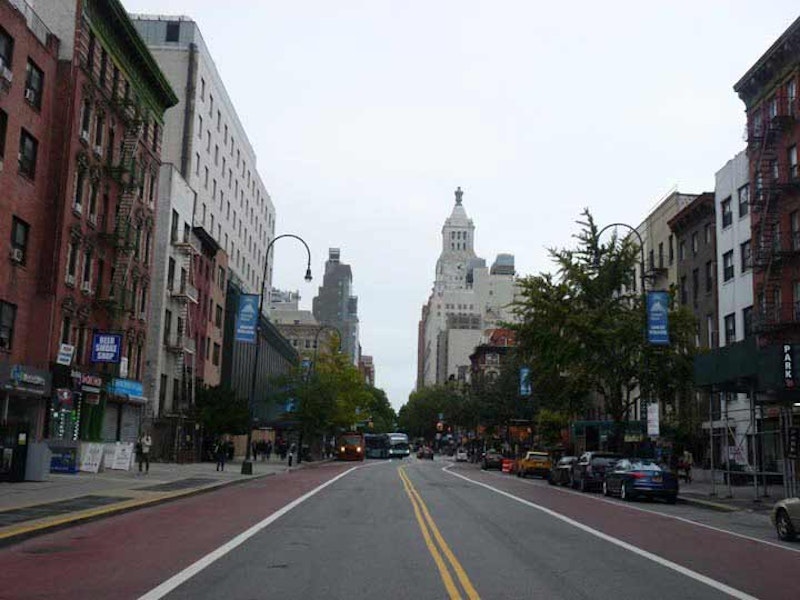One Labor Day, years ago, I tuned into the Jerry Lewis Labor Day telethon. Lewis took a number of breaks during the daylong show, and during that time, the network threw it back to the local studio in Secaucus, which had its own acts lined up. One of them, to my amazement, was Sylvain and his band at the moment, who were doing a song named “14th Street Beat,” a catchy number that featured subway noise, including the ‘bing-bong” noise the doors make when they close. Sylvain played guitar in the New York Dolls in the early-1970s, with Sylvain, Johnny Thunders, Jerry Nolan, and front man David Johansen. The Dolls, who were known to take the stage in drag, didn’t sell many records, but were influential in the new-wave scene emanating from the Lower East Side in the 1970s.Thunders and Nolan died young, and are interred in Mount St. Mary’s Cemetery in Queens, a spot visited by a FNY tour in the summer of 2019. Johansen has gone on to have hits as Buster Poindexter, and Sylvain continues to play. Here’s a 2016 rendition of “14th Street Beat.”
What brought this to mind? The Department of Transportation recently cleared out 14th St.—of most traffic, that is. Most cars can’t now travel on 14th St. between six a.m. to 10 p.m., with buses and trucks making local deliveries still permitted on the formerly bustling street. I’ve walked most of 14th St. before but decided to check it out, guessing the photo opportunities would be augmented without SUVs getting in the way.

I began at the 8th Ave. A train station at W. 14th, and walked east. Between 7th and 8th Aves. on 14th, you see the last vestiges of 14th St.’s original residential district, rows of Italianate townhouses constructed from the late-1840s into the 1850s. Developer Andrew Norwood occupied the center building in this grouping. The building on the right, flying the Spanish flag, is home to Spanish restaurant La Nacional, as well as the Spanish Benevolent Society.
La Nacional, which was also the name of the Spanish Benevolent Society, and Our Lady of Guadalupe church (see below) are the remnants of a small enclave of Spanish immigrants who settled in Chelsea as well as Brooklyn Heights. In H.P. Lovecraft’s “Cool Air,” set on West 14th Street, a Doctor Muñoz self-animates his own corpse by keeping his apartment artificially cold by means of a complicated apparatus in the era before widespread air conditioning in 1921. When the power fails, Dr. Munoz comes to a gruesome finish.
When John Randel drew up Manhattan’s grid system during a period of surveying from 1805-1810, he designated 14th, 23rd, 34th, 42nd, and 57th Sts. to be extra-wide south of Central Park. These streets were seemingly chosen at random, but my guess is that the Bloomingdale Rd., the generally northbound trail that traversed Manhattan Island and ultimately became Broadway, intersected Randel’s planned north-south avenues from 4th (Park) to 8th at roughly those streets. That’s my best guess, though ultimately, the intersections are a bit off.
Manhattan’s population spread slowly at first north, and 14th St. was laid out but mostly unpopulated by the 1840s, and only then were residences constructed. Later, Manhattan’s entertainment district gravitated north from the Bowery to Union Square, and in the early-1900s, to Times Square. After these early Italianate buildings, grand mansions were built along 14th, but they were short-lived. Today, 14th St. still retains a largely grungy atmosphere, with low-and mid-priced businesses interspersed with modern apartment buildings. Macy’s early headquarters was on 6th Ave. between W. 13th and 14th, but moved uptown along with most late 19th-century “Ladies’ Mile emporiums.

You’ve heard of storefront churches. At #229 W. 14th, there’s a residential building-front church. It was built as one of the row of townhouses along the block in the 1850s, but it was converted to the Roman Catholic Our Lady of Guadalupe in 1921, serving what at the time was large number of Spanish immigrants in the area, most of whom were Catholic. The Spanish for “Our Lady of Guadalupe” can be seen above the entrance, with an interlocking “SH” digraph above the second floor window, which likely stands for the “Sacred Heart” often found in Church iconography. No longer a church, the building now holds the offices of the merged parish of Our Lady of Guadalupe and St. Bernard.

I was perplexed for years by this handsome, five-story red brick apartment building at the SW corner of 7th Ave. and W. 14th. Why? There’s a statue of a female figure on the second floor, above the entrance, with a partial inscription that says “Jear.” I figured it out: it represents Joan of Arc, or Jeanne d’Arc in France. The other letters have since broken off or worn away, including the “n,” which now looks like an “r.” If you’ve heard the term “French flats” for apartment buildings, it may come from here, as this was one of the first buildings to adopt the French practice of many living spaces in one building. The building shown here, designed by architect James W. Cole, goes back to 1888. The front entrance is a treat too, with its pairs of caryatids and guardian beasts.

154 W. 14th, on the southeast corner of 7th Ave., is a concoction of colored terra cotta exteriors. It was built as a loft by real estate developer Leslie Palmer in 1914. Palmer suspected there would be a lot more business on 7th Ave. in the next few years as the 7th Ave. IRT subway, today’s #1,2,3 trains, would open in 1918. It was designed by Herman Maeder, an architect who’d studied under Ernest Flagg (Singer Tower, Flagg Court in Brooklyn). The glazed terra cotta, in white, gold, green and blue, was produced by the New York Architectural Terra Cotta Company—whose chief director was Leslie Palmer.

The Salvation Army, founded by William Booth, has been a presence on W. 14th St. since the 1890s. Its weird, fortress-like building at #120 W. 14th was constructed in the 1930s, with Robert Walker, the architect of a number of prominent NYC Art Deco office towers.
A quotation by William Booth in raised letters can be seen at the entrance:
“While women weep, as they do now, I’ll fight
While little children go hungry, as they do now, I’ll fight
While men go to prison, in and out, in and out, as they do now, I’ll fight
While there is a drunkard left,
While there is a poor lost girl upon the streets,
While there remains one dark soul without the light of God,
I’ll fight, I’ll fight to the very end!”

This narrow tower on W. 14th just off 6th was one of the last buildings constructed for Macy’s when the World’s Biggest Store occupied a complex of buildings on W. 13th, 14th and 6th Ave. until its move to Herald Square in 1902. The word “Macy’s” was formerly visible above the front entrance. If you go around the corner to W. 13th, in one of the former Macy’s buildings now owned by the New School you can make out some red stars, the longtime Macy’s symbol (founder R. Hussey Macy was at sea and had a red star tattoo).

New School University Center, southeast corner of E. 14th Street and 5th Ave., is a grim modernist building home to the school’s classrooms, a library-research center, a new auditorium, a cafeteria, an event café, and a 600-bed student residence, is the school’s new flagship building. The New School isn’t new: it celebrated its centennial in 2019.
These “bigloop” lampposts, installed on 14th St. in the early-1990s, can be seen as a modern nod to the curved Bishop Crook lamps which arrived in NYC in the 1910s and beginning in the 1990s, have been revived in many places. 14th is so far the only street to get the “bigloops” though they can also be found on the Williamsburg Bridge.

One more impressive former department store with a cast iron front, this one at 22-26 E. 14th between 5th and University Pl., went up in 1881 and was originally the Baumann Brothers Furniture and Carpets, designed by Scottish architect brothers David and John Jardine.
According to the Neighborhood Preservation Center, for eight decades the ground story contained 5-10-and-25-cent stores, beginning with the fourth Woolworth store in Manhattan (1900-28), acclaimed at its opening as “the largest ten-cent store in the world” and in 1910 the location of the chain’s first lunchroom. This space was later a store for F. & W. Grand, H.L. Green, and McCrory. The upper stories were leased for over eight decades for show rooms and manufacturing by firms related to the textile and sporting goods industries, as well as a gymnasium and classrooms for the Delehanty Institute (1930-63), which trained candidates of the Police and Fire Departments. The upper stories are currently used as an annex to the Parsons School of Design.
Next week: Union Square and beyond.
—Kevin Walsh is the webmaster of the award-winning website Forgotten NY, and the author of the books Forgotten New York (HarperCollins, 2006) and also, with the Greater Astoria Historical Society, Forgotten Queens (Arcadia, 2013)

